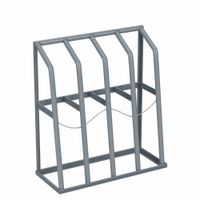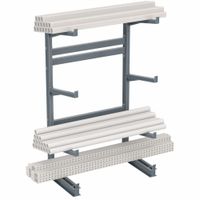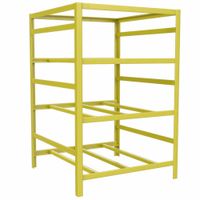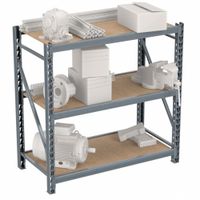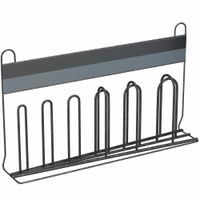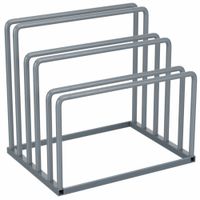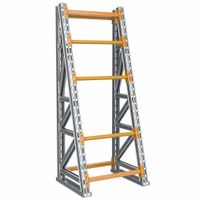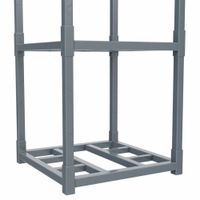Call +(254) 703 030 000 / 751 483 999 / 721 704 777
- Home
- Material Handling
- Storage Workspace
- Shelving Storage Racks
.....Read More
Frequently Asked Questions
What are the different types of shelving and storage racks?
1. **Pallet Racking**: Designed for heavy-duty storage, pallet racking systems are used in warehouses to store large quantities of goods on pallets. Types include selective, drive-in, drive-through, push-back, and pallet flow racks.
2. **Cantilever Racks**: Ideal for storing long, bulky items like lumber, pipes, or metal rods. They have arms extending from a central column, allowing for easy loading and unloading.
3. **Wire Shelving**: Made of metal wires, these shelves are lightweight, adjustable, and allow for air circulation. Commonly used in retail, kitchens, and healthcare settings.
4. **Boltless Shelving**: Easy to assemble without tools, these shelves are versatile and can be adjusted to different heights. Suitable for light to medium-weight items.
5. **Mezzanine Flooring**: A raised platform that creates additional storage space above existing floor space. Often used in warehouses to maximize vertical space.
6. **Mobile Shelving**: Mounted on tracks, these shelves can be moved to create compact storage solutions, ideal for offices, libraries, and archives.
7. **Industrial Shelving**: Heavy-duty shelves designed for industrial environments, capable of holding large, heavy items. Often made of steel or other durable materials.
8. **Gondola Shelving**: Common in retail stores, these freestanding units have adjustable shelves and are used to display merchandise.
9. **Floating Shelves**: Wall-mounted shelves with no visible brackets, used for decorative purposes in homes and offices.
10. **Corner Shelving**: Designed to fit into corners, maximizing space in small rooms or awkward areas.
11. **Adjustable Shelving**: Allows for customization of shelf height and spacing, suitable for various storage needs.
12. **Slatwall and Gridwall Panels**: Used in retail for displaying products, these panels allow for hooks, shelves, and baskets to be easily rearranged.
How do I choose the right shelving or storage rack for my needs?
1. **Assess Your Needs**: Determine what items you need to store. Consider size, weight, and quantity. This will help you decide on the type and strength of shelving required.
2. **Space Measurement**: Measure the area where the shelving will be placed. Consider height, width, and depth to ensure a good fit and to maximize storage capacity.
3. **Weight Capacity**: Choose shelving that can support the weight of your items. Heavy-duty racks are ideal for industrial use, while lighter options may suffice for home or office use.
4. **Material**: Select materials based on durability and environment. Metal shelves are strong and durable, wood offers a classic look, and plastic is lightweight and resistant to moisture.
5. **Adjustability**: Opt for adjustable shelves if you need flexibility in storage. This allows you to change shelf heights to accommodate different items.
6. **Accessibility**: Consider how often you need to access the items. Open shelving provides easy access, while closed units offer protection from dust and dirt.
7. **Aesthetic and Design**: Choose a style that complements your space. Shelving can be both functional and decorative, especially in living areas.
8. **Budget**: Determine your budget. Prices vary based on material, size, and brand. Balance cost with quality to ensure longevity.
9. **Safety Features**: Look for features like wall-mounting options or anti-tip brackets, especially if the shelving will be in a high-traffic area or if children are present.
10. **Future Needs**: Consider potential future storage needs. Modular or expandable systems can grow with your requirements.
By evaluating these factors, you can select shelving or storage racks that effectively meet your needs.
What are the benefits of freestanding shelving versus wall-mount shelving?
Freestanding shelving offers several benefits over wall-mounted shelving. Firstly, it provides flexibility in placement, allowing you to rearrange or relocate the shelves without the need for tools or wall modifications. This is particularly advantageous for renters or those who frequently change their room layouts. Freestanding units can also be used as room dividers, adding functionality and style to open spaces.
In terms of installation, freestanding shelves require no drilling or wall damage, making them ideal for preserving wall integrity. This is beneficial in spaces with delicate wall materials or where wall-mounted options are impractical due to structural limitations. Additionally, freestanding shelves often have a higher weight capacity, as they distribute weight across the floor rather than relying on wall anchors.
Freestanding shelving units come in a variety of styles, sizes, and materials, offering more design versatility to match existing decor. They can be easily customized with additional units or accessories, providing scalable storage solutions. This adaptability is useful for growing storage needs or changing aesthetic preferences.
Moreover, freestanding shelves are generally easier to clean and maintain, as they can be moved to access hard-to-reach areas. They also offer storage on both sides, maximizing utility in larger spaces.
In contrast, wall-mounted shelving is more space-efficient, as it utilizes vertical space and keeps floors clear. However, it requires more permanent installation and may not be suitable for all wall types. Freestanding shelving, with its mobility, ease of installation, and versatility, is often a more practical choice for those seeking adaptable and non-permanent storage solutions.
How do I properly install and secure shelving and storage racks?
1. **Planning and Preparation**:
- Assess the weight and size of items to be stored.
- Choose appropriate shelving material (metal, wood, plastic) based on load capacity.
- Measure the space to ensure proper fit.
2. **Tools and Materials**:
- Gather necessary tools: drill, level, stud finder, screws, anchors, brackets.
- Purchase shelving units or materials for custom shelves.
3. **Installation**:
- Locate wall studs using a stud finder for secure mounting.
- Mark the desired height and ensure it is level.
- For heavy loads, use wall anchors if studs are not available.
- Attach brackets or supports securely to the wall.
- Place shelves on brackets and secure them with screws.
4. **Securing Shelves**:
- Use anti-tip brackets or straps for tall shelving units.
- Ensure shelves are level to prevent items from sliding off.
- Distribute weight evenly across shelves.
5. **Safety Measures**:
- Avoid overloading shelves beyond their weight capacity.
- Store heavier items on lower shelves to maintain stability.
- Regularly inspect shelves for signs of wear or damage.
6. **Final Checks**:
- Ensure all screws and brackets are tightly secured.
- Test stability by gently shaking the shelves.
- Adjust as necessary to maintain safety and functionality.
What materials are best for shelving and storage racks?
The best materials for shelving and storage racks depend on the intended use, load capacity, and environment. Here are some top choices:
1. **Steel**: Ideal for heavy-duty storage, steel is strong, durable, and can support substantial weight. It's often used in industrial settings. Galvanized or stainless steel options resist rust and corrosion, making them suitable for humid or outdoor environments.
2. **Wood**: Offers a classic look and is versatile for both decorative and functional shelving. Hardwood varieties like oak or maple are strong and durable, while softwoods like pine are more affordable but less robust. Wood is best for indoor use due to its susceptibility to moisture and pests.
3. **Wire**: Made from steel or chrome-plated metal, wire shelving is lightweight yet strong. It allows for air circulation, making it ideal for kitchens, pantries, and retail displays. It's also adjustable and easy to clean.
4. **Plastic**: Lightweight and resistant to moisture, plastic shelving is perfect for environments prone to dampness, such as basements or garages. High-density polyethylene (HDPE) is particularly durable and can support moderate weight.
5. **Particleboard/MDF**: Cost-effective and available in various finishes, these materials are suitable for light to medium loads. They are best used indoors and should be kept away from moisture to prevent warping.
6. **Aluminum**: Lightweight and resistant to rust, aluminum is suitable for both indoor and outdoor use. It’s not as strong as steel but is ideal for moderate loads and environments where corrosion is a concern.
Choosing the right material involves considering the weight of stored items, environmental conditions, and aesthetic preferences. Each material offers unique benefits tailored to specific needs.
How do I maintain and clean shelving and storage racks?
To maintain and clean shelving and storage racks effectively, follow these steps:
1. **Regular Inspection**: Conduct routine checks for any signs of damage, rust, or wear. Tighten loose bolts and replace damaged parts immediately to ensure safety and stability.
2. **Dusting and Cleaning**: Use a microfiber cloth or duster to remove dust and debris from shelves. For deeper cleaning, use a mild detergent mixed with water. Avoid harsh chemicals that can damage surfaces.
3. **Rust Prevention**: For metal racks, apply a rust-inhibiting primer or paint. Regularly check for rust spots and treat them promptly to prevent spreading.
4. **Weight Distribution**: Ensure items are evenly distributed to prevent overloading and potential collapse. Follow manufacturer guidelines for weight limits.
5. **Labeling and Organization**: Clearly label shelves to maintain order and make it easier to locate items. Use bins or containers to group similar items together.
6. **Floor Cleaning**: Keep the area around the shelves clean. Sweep and mop regularly to prevent dust accumulation and potential tripping hazards.
7. **Ventilation**: Ensure proper airflow around storage areas to prevent moisture buildup, which can lead to mold or rust.
8. **Safety Checks**: Regularly review safety protocols, ensuring that all items are stored securely and that there are no obstructions in aisles or emergency exits.
9. **Training**: Educate staff on proper loading techniques and maintenance procedures to ensure consistent care and safety.
10. **Documentation**: Keep records of maintenance activities and inspections to track the condition of shelving and address issues promptly.
By following these steps, you can maintain clean, safe, and efficient shelving and storage racks.
What are the weight limits for different types of shelving and storage racks?
Weight limits for shelving and storage racks vary based on the type, material, and design. Here are some general guidelines:
1. **Wire Shelving**: Typically used in homes and offices, these can support between 200 to 800 pounds per shelf, depending on the size and construction.
2. **Wood Shelving**: Common in residential settings, weight capacity ranges from 150 to 300 pounds per shelf. Solid wood can support more weight than particleboard.
3. **Metal Shelving**: Often used in industrial settings, these can hold between 500 to 2,000 pounds per shelf. Heavy-duty versions can support even more.
4. **Pallet Racks**: Used in warehouses, these can support thousands of pounds per level. Standard pallet racks can hold between 2,000 to 5,000 pounds per beam level.
5. **Cantilever Racks**: Designed for long, bulky items, these can support between 500 to 5,000 pounds per arm, depending on the design and material.
6. **Boltless Shelving**: Easy to assemble, these can support between 200 to 1,000 pounds per shelf, suitable for medium-duty storage.
7. **Mobile Shelving**: Used in offices and libraries, these systems can support between 500 to 1,000 pounds per shelf, depending on the track and wheel system.
8. **Plastic Shelving**: Lightweight and often used for light-duty storage, these can support between 50 to 200 pounds per shelf.
Always check the manufacturer's specifications for exact weight limits, as exceeding them can lead to structural failure and safety hazards.
